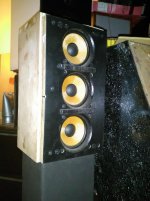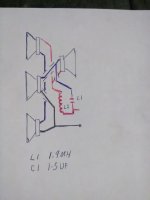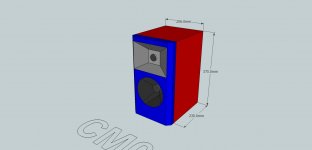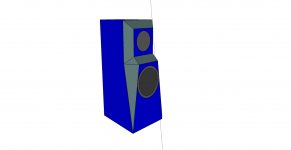So it looks like "safest" solution for DIY ?
Are there some proved DIY designs with very good sound, better than similar expensive commercial speakers ? (2 way with sealed bass & FR). Because i live in Europe, I would prefer construction with drivers that I can buy here in european e-shops.
Many drivers mentioned here are found in the soundimport.eu shop (from the Netherlands), that i use a lot recently to get my drivers. Most are found here locally if you search a bit. I got the best experience on low level listening with good fullrange drivers like the Mark Audio drivers, wich have a low RMS value mostly.
And about a WAW (woofer assisted wideband), I use a Mark Audio Alpair 10.3 in a 11.5L sealed cabinet with a Scanspeak 26W/8534G00 woofer in a 77L sealed cabinet with a 1st order serial crossover at 250Hz. This also works rather well on low power, even with deep bass (F6 of 31Hz). I did ran that setup for a while with an 8w 300B SET amp wich worked well But the set was not mine, and when the owner returned from abroad i had to give it back... Something similar could work for you. A proven design is the Planet 10 Mark Audio Alpair 7.3/12PW MTM design. You need to contact him for the plans. There is also the Scanspeak 10F/Dayton RS225 design from xrk971
Alpair 12pw/7.3/12pw MTM
10F/8424 & RS225-8 FAST / WAW Ref Monitor
Last edited:
There was an interesting discussion on this topic of quality at low volumes a few years ago: Considerations for good performance at low volume
Very briefly, many consider that a driver with low mechanical resistance, Rms, is an important factor for good low level listening.
Interesting thread. Read Post 9 and quick scan of other posts. Looking at my woofers Rms's and specs and thinking about their bass sound at low volume, and wondering if there's some merit. Haven't come up with anything yet. Maybe it will factor in?
I keep thinking the bulk of the issue is:
HQ low volume listening =(critically damped to flat box alignment)+(high signal to noise ratio of the room)+(relative fr of bass region is higher than mid/treble)
the above advice to look at the thread by xrk971 on the FAST design with
RS225-8 and SS 10F/8424 is good. You may want to listen to some sample recordings posted there (with good headphones of course).
I would actually recommend a WFW version with 2x RS225-8 and SS 10F/4424 (4 ohm version of the 10F driver for increased sensitivity).
As mentioned the bass needs a boost to be audible at lower level playback (see equal loudness curves). A boosted bass in a passive solution though translates to too much bass at higher volumes.
If the metal cone did not satisfy you, you can always go for paper drivers, run them at their sweet spot and deal with cone break up issues at higher volumes and also off-axis. Mind you large cones are also deeper and beam sooner and cannot be successfully merged off-axis with a much smaller driver above so I would not recommend those.
p.s. in the small driver shoot out you can listen to different drivers e.g. Visaton B80 (in group 3) etc. You can ask xrk at which volume he recorded those.
A Subjective Blind Comparison of 2in to 4in drivers - Round 3
RS225-8 and SS 10F/8424 is good. You may want to listen to some sample recordings posted there (with good headphones of course).
I would actually recommend a WFW version with 2x RS225-8 and SS 10F/4424 (4 ohm version of the 10F driver for increased sensitivity).
As mentioned the bass needs a boost to be audible at lower level playback (see equal loudness curves). A boosted bass in a passive solution though translates to too much bass at higher volumes.
If the metal cone did not satisfy you, you can always go for paper drivers, run them at their sweet spot and deal with cone break up issues at higher volumes and also off-axis. Mind you large cones are also deeper and beam sooner and cannot be successfully merged off-axis with a much smaller driver above so I would not recommend those.
p.s. in the small driver shoot out you can listen to different drivers e.g. Visaton B80 (in group 3) etc. You can ask xrk at which volume he recorded those.
A Subjective Blind Comparison of 2in to 4in drivers - Round 3
Last edited:
Dear bh69 (OP),
I would advise not to get carried away by the low SPL requirement, as it does not change the frequencies you need to reproduce (20Hz-20kHz) or their wavelengths. Do pick a large enough woofer and a nice 1" compression driver, if you really want to experience the full dynamic range of recordings. Also remember that the SPL at the diaphragm needs to be much higher, depending on the distance to the listening position. Besides, 60dB is going to be "just peanuts" in a damped room, so it is better to design for the regular 90dB, with intentions of listening at a modest 70-75dB (DVD reference level).
Your idea of a sealed box is a very good one. A sealed box provides better transient response, low group delay (good bass SQ), is smaller (wall mounting possible), more forgiving and is easier (& cheaper) to construct. Further, if your woofer has enough Xmax, a Linkwitz transform may also be applied to shift the box cutoff all the way to 20Hz, totally eliminating the need for a sub-woofer (for your target SPL and power). The resulting savings in money could then be used for a processor, room treatment etc.
Regards.
I would advise not to get carried away by the low SPL requirement, as it does not change the frequencies you need to reproduce (20Hz-20kHz) or their wavelengths. Do pick a large enough woofer and a nice 1" compression driver, if you really want to experience the full dynamic range of recordings. Also remember that the SPL at the diaphragm needs to be much higher, depending on the distance to the listening position. Besides, 60dB is going to be "just peanuts" in a damped room, so it is better to design for the regular 90dB, with intentions of listening at a modest 70-75dB (DVD reference level).
Your idea of a sealed box is a very good one. A sealed box provides better transient response, low group delay (good bass SQ), is smaller (wall mounting possible), more forgiving and is easier (& cheaper) to construct. Further, if your woofer has enough Xmax, a Linkwitz transform may also be applied to shift the box cutoff all the way to 20Hz, totally eliminating the need for a sub-woofer (for your target SPL and power). The resulting savings in money could then be used for a processor, room treatment etc.
Regards.
Last edited:
I'd recommend class d amps, much better than an average power ( ie to much ) AB at low volumes ( in my opinion ), I found an ESS dac to smooth at low volumes. You're possibly using less than 1 watt, so a low power ( class d ) amp would be my recommendation first.
I'd recommend class d amps, much better than an average power ( ie to much ) AB at low volumes ( in my opinion ), I found an ESS dac to smooth at low volumes. You're possibly using less than 1 watt, so a low power ( class d ) amp would be my recommendation first.
I have looked at some rapsberry based streamer/DAC/USB players with class D mini amp, it could be interresting solution
I'm currently listening to " Channel the spirits " by the comet is coming, on floor standing semi omnis driven by a very cheep pam amp, about 3watt per channel ( although I'm using 3 pre used AAA batteries, so it'll be a bit less than 3watt ) and a sandscript 10th DAC. At 50 db it's laying down a phat grove, improving as the amp runs in ( it's first test ).
Thank you very much for all anwers and ideas. I must say I'm a bit overhelmed now 🙂 There are many possibilities and many things to choose from, it seems to be very difficult without enough knowledge.
Classic sealed 2-way or 3-way ? Woofer plus fullrange ? Big horn with FR only ? Active subwoofers and satelites ?
Common hifi amp (like PM7000N as mentioned in my initial question) or small D or T class amp (or two with miniDSP ?)
Passive crossover or miniDSP ? How is DAC in miniDSP compared to my Audiolab M-DAC or DAC in Marantz PM7000N ?
And what about magnetic planar speakers ? I saw some interesting DIY on youtube, their sound seems to be very interesting for classic music and quiet listening (but I'm not sure how universal they are, how jazz/blues/rock music sounds with this type of speakers ?).
Trying to make my own design can be interesting, but probably not realistic according to my zero experience in this area (although I have a technical education). I'm afraid there are many possible pitfalls and such project can lead to wasting time and money.
Classic sealed 2-way or 3-way ? Woofer plus fullrange ? Big horn with FR only ? Active subwoofers and satelites ?
Common hifi amp (like PM7000N as mentioned in my initial question) or small D or T class amp (or two with miniDSP ?)
Passive crossover or miniDSP ? How is DAC in miniDSP compared to my Audiolab M-DAC or DAC in Marantz PM7000N ?
And what about magnetic planar speakers ? I saw some interesting DIY on youtube, their sound seems to be very interesting for classic music and quiet listening (but I'm not sure how universal they are, how jazz/blues/rock music sounds with this type of speakers ?).
Trying to make my own design can be interesting, but probably not realistic according to my zero experience in this area (although I have a technical education). I'm afraid there are many possible pitfalls and such project can lead to wasting time and money.
Last edited:
Sorry to complicate things further, but what about double chamber aperiodic bass loading ? Lovely tight clean bass. I quite like the sound of a small full range with a woofer to augment bass. My audiolab Q DAC is MUCH to smooth at low listening levels for my taste, but the M DAC is supossed to be better.
Thanks for interesting info, it looks good. Except it seems to be sensitive to proper "tuning" to get it really work as resonance damping, isn't it?
I have looked at magnetic planar speakers - it's a pitty but it seems to have toomuch problems (low impedance, room and listening position picky, resonances ..).
I have thought about FR plus bass too. Because woofer should play relatively high (300-400hz ?), it should be close to FR driver. With big woofer (10/12/15") it's problem, more important for small listening distance (<2m).
What about 2x8" d'apollito ? Low crossover frequency should be good for this ?
Box will be tall (130-140cm), but it's not a problem. Separate sealed chambers for each driver could lead vertically to bottom where second chamber for aperiodic damping can be placed and filled wit rockwool.
I like this idea, what do you think about ?
I have thought about FR plus bass too. Because woofer should play relatively high (300-400hz ?), it should be close to FR driver. With big woofer (10/12/15") it's problem, more important for small listening distance (<2m).
What about 2x8" d'apollito ? Low crossover frequency should be good for this ?
Box will be tall (130-140cm), but it's not a problem. Separate sealed chambers for each driver could lead vertically to bottom where second chamber for aperiodic damping can be placed and filled wit rockwool.
I like this idea, what do you think about ?
Well, if you're planning to sit at 2m, I suggest you consider studio monitors that are optimised for near-field listening. Here's a link to the review and measurement of such an MTM studio monitor (HF in between).
http://www.audioheritage.org/vbulletin/showthread.php?38012-JBL-DMS-1-Experience-and-Measurement
http://www.audioheritage.org/vbulletin/showthread.php?38012-JBL-DMS-1-Experience-and-Measurement
I considered studio monitors too, but I finally abandoned the idea because most of people say that monitors are not pleasant and "musical". I looked for example at Neumanns KH120 with subs or KH310 (expensive), but found that people judge them as not really pleasant for relaxed hifi listening. And most of monitors (except cheaper ones) have no level adjustmenst so some preamp or at least attenuator is needed.
AE1 active looks interesting, it has level adjustment to set maximum level and than I can use M-DAC digital volume for fine volume setting. But I'm not sure about their quality (and quality of built in amps) and how they work for low volume listening ?
AE1 active looks interesting, it has level adjustment to set maximum level and than I can use M-DAC digital volume for fine volume setting. But I'm not sure about their quality (and quality of built in amps) and how they work for low volume listening ?
You write: "Most people say that monitors are not pleasant and "musical".
Eventually what matters is your money, your effort and your satisfaction, so start listening yourself. Try to get auditions of ready-to-buy speakers or alternatively design something using your technical knowledge. Only you seem to know what exactly satisfies you. Are you using headphones while listening to speaker videos on youtube? That's important.
EDIT:Superlative musiciality and naturalness is mostly seen in large horn speakers like Jubilee. However, I am afraid they may not even fit inside your room.
Eventually what matters is your money, your effort and your satisfaction, so start listening yourself. Try to get auditions of ready-to-buy speakers or alternatively design something using your technical knowledge. Only you seem to know what exactly satisfies you. Are you using headphones while listening to speaker videos on youtube? That's important.
EDIT:Superlative musiciality and naturalness is mostly seen in large horn speakers like Jubilee. However, I am afraid they may not even fit inside your room.
Last edited:
Your 2x8 D'apolito sound cool, if you're using separate sealed chambers you could do something like the box in a box speakers I did, if you do a search for " biab " one this forum you might find them, What are you considering as a " tweeter " ? - I'm tempted to use the ceramic drivers form a mini X blutooth speaker for mid/tweeters. I haven't had a problem tuning aperiodic vents, stick a 1 ohm resistor in series with the woofer to lower the electrical damping and modify the vent until the boom goes away. Measuring the impedance curve is better if you can do this.I have looked at magnetic planar speakers - it's a pitty but it seems to have toomuch problems (low impedance, room and listening position picky, resonances ..).
I have thought about FR plus bass too. Because woofer should play relatively high (300-400hz ?), it should be close to FR driver. With big woofer (10/12/15") it's problem, more important for small listening distance (<2m).
What about 2x8" d'apollito ? Low crossover frequency should be good for this ?
Box will be tall (130-140cm), but it's not a problem. Separate sealed chambers for each driver could lead vertically to bottom where second chamber for aperiodic damping can be placed and filled wit rockwool.
I like this idea, what do you think about ?
What are you considering as a " tweeter " ?
I don't know - maybe some Fostex will be good enough ?
bh69, you sure are stirring up the past and the new
Consider Original Elsinore with felt trapezoid. Very forgiving(sins of omission) in the treble, Easy to drive, magical integration, all of this make them good at low and high volumes. I would modify them by examining the box alignment, hence, box volume with possible adjustments, change them to front ported, 2 ports centered if air velocity, port resonance and length are suitable.
Eight years ago, I examined my own test speaker with felt trapezoid and gave up quickly based on the response I was measuring, and implementing felt is not easy considering I have aesthetic goals in mind. I stayed with drawing 2.
Hmm, I have a pair of Elsi boxes and might examine these changes I mention for my home theatre.. The forward felt baffle vs back beveled baffle change would need to be examined very closely. I might revisit..
Finding your exact personal solution through suggestions has poor odds. You should design, build, measure and make changes yourself, measure again, repeat, over an over. It opens up a new world

Consider Original Elsinore with felt trapezoid. Very forgiving(sins of omission) in the treble, Easy to drive, magical integration, all of this make them good at low and high volumes. I would modify them by examining the box alignment, hence, box volume with possible adjustments, change them to front ported, 2 ports centered if air velocity, port resonance and length are suitable.
Eight years ago, I examined my own test speaker with felt trapezoid and gave up quickly based on the response I was measuring, and implementing felt is not easy considering I have aesthetic goals in mind. I stayed with drawing 2.
Hmm, I have a pair of Elsi boxes and might examine these changes I mention for my home theatre.. The forward felt baffle vs back beveled baffle change would need to be examined very closely. I might revisit..
Finding your exact personal solution through suggestions has poor odds. You should design, build, measure and make changes yourself, measure again, repeat, over an over. It opens up a new world
Attachments
- Home
- Loudspeakers
- Multi-Way
- DIY speakers for HQ low volume listening




